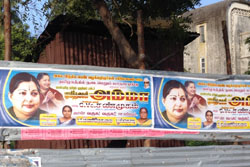Tamil Land’s long, beautiful white sand beaches literally and figuratively look to Southeast Asia. For literally thousands of years, the region has maintained deep trading relations with Singapore, Malaysia, Indonesia, Thailand, Vietnam and Myanmar. As the southernmost point in India, it also connects that region to the western Indian Ocean, and its monsoon buffeted trade routes to Africa and the Middle East. One of out of five people here are Christian. St. Thomas the apostle is said to be buried in Chennai. More people here speak English than Hindi. Rivalries with China and Pakistan feel very far away.
Under British colonial rule, Tamil Nadu was one of the first parts of India to push for independence. Even during the early years of free India, the call for secession remained strong, leading to one of India’s first regional parties—the DMK (which stands for Dravidian Progressive Federation). That ended after 1962, when Prime Minister Nehru pushed through a constitutional amendment making it a crime to advocate for secession. The DMK became loyal to the central constitution, and the party began to compete for electoral office.
But since it has always seen itself as far from Delhi, perhaps, party politics here have remained a largely local affair. The two local parties are built around personalities and patronage. They are only barely distinct from one another in ideology, unlike the two nation-wide parties—the socialist-secular Congress Party and the nationalist-Hindu BJP. The Tamil Nadu state government is currently controlled by the DMK’s rival ADMK, and the current chief minister, J. Jayalalitha is a famous actress who combines Ronald Reagan’s on-screen charisma with Huey Long’s populism and patronage. Her personal and political history is rich with steamy and salacious connections. Her face graces not only the front pages of local language newspapers, but also billboards and advertisements all over the city.
|
|
|
A poster of Tamil Nadu Chief Minister J. Jayalalitha. |
As a result, the Congress Party and BJP have very little local traction. And since these parties generally can no longer form governments by themselves, they need to look to the regional parties to form coalitions. That means both parties vie for Tamil Nadu’s members of parliament in Delhi. And that gives this state an oversized role in national affairs. As with one or two other regional parties, it has emerged as a power broker. That empowers the regions at the national level, but leaves open the question of what they get in return on international affairs.
Precisely for all these reasons, Tamil Land is the appropriate place to begin an exploration of how the states of India and the provinces of China affect their foreign policy—and how national foreign policies affect distinct localities. To see either of these countries as a monolith would be as mistaken as seeing the United States or EU as unitary actors. Both countries are composed of vibrant localities with distinct personalities and interests. Think of California or the Czech Republic, Germany or Georgia, New York or the Netherlands, the United Kingdom or Utah. India and China are unions, yet those unions operate in diverse ways, just as the United States and EU are very different federal animals. As a result, in each place, sovereignty has a range of internal and external meanings.
For American foreign policy officials, federalism is an echo. Even if California, Nebraska or New York don’t have their own foreign policies, policy-makers and diplomats are acutely aware of what senators from those very different places think about the world. A Republican governor in California passed among the most ambitious climate change laws on the planet, while a Democratic Senator from Nebraska helped to kill a similar law for the nation. And if American states echo in the U.S. system, the views of Germany, France, the UK—not to mention Greece, Poland or Ireland—are the banging drums of the EU’s nascent foreign policy. ‘
 |
|
The Cathedral of San Thome, a church built on the site where Apostle Thomas is said to have been buried. |
As my family and I travel through India and China, I’ll be following these forces. We will be based in three cities in each country—the political capital, the financial capital, and a third, less-well-known industrial city. In India, we will be in New Delhi, Mumbai and Chennai. In China, we will be in Beijing, Shanghai and Chengdu. I will try to interview local academics, policymakers, industry representatives, civil society organizations, and media representatives. Our family will seek to visit a number of civil society organizations, particularly those that emphasize environmental sustainability. We will be greatly aided in our work by the Brookings-Tsinghua Center in Beijing, the John L Thornton China Center at Brookings, and the network of supporters of Brookings’s work in India.
In addition to getting to know these places, we will also make multi-day trips to other cities and provinces. In India, we hope to get to Hyderabad, Bangalore, Ahmadabad, Jaipur, Lucknow, and Kolkata. In China, we’ll travel to Xian, Nanjing, Chongqing, Hong Kong, and Shenzhen. I hope to find there, what I’m finding here: the grand and complex dance between local and national that makes these unions work—or not work. In my next post, I’ll explore how that has worked on some of the major national security challenges, where central governments seem to hold sway over the localities.



Commentary
Tamil Nadu: From Union-Breaking to King Making
January 13, 2012